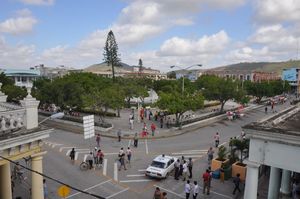

Calixto García Íñiguez Park, Holguín
Discover the warm Calixto García Íñiguez Park from where you can admire the imposing building of La Periquera.
This stunning monumental square, located in the center of the city, is part of the Central Park of the city and is considered as an expression of identity in Holguín.
Designed at the beginning of the 18th century, in 1720, by Gregorio Francisco, it was opened with the name of Plaza de Armas Square and it has been having different roles since its construction, as Market or Military function and, later on, was used on several occasions as theater scenario.
At the beginning of the Independence War, the square was almost destroyed by the different war events that developed around La Periquera, the colonial mansion that can be clearly seen from the center of the square. Later on, it was established as political center of the city due to the strategic place it occupies.
In 1898, with the death of the General Calixto García, it is decided to rechristen the square with its current name.
In relation to the wonderful construction which can be seen in the square and its surroundings, it should be mentioned Las Leyes de India Laws, according to which only in places like this can be built Institutions and Noble Houses.
Known in 1812 as the Plaza de la Constitución Square to honour Spain, in 1839 it became in Paseo de Isabel II Promenade disappearing the Market, relocated in the Plaza San José Square. At the same time begins the Plaza Project in the center of the park, which you can see while having a calm walk by the square and is paved with mud slabs, which in the 20th century were substituted by concrete and granite. Benches were also set up, and the lights of the park and it was began to sow the first trees.
Along the 20th century it will suffer new remodelling on its constructive elements and will be decorated with two outstanding monuments for the local culture. On the one hand, you will find a marble statue of the Major General Calixto García, located in the center of the rotunda, unveiled in 1916. Brought from Italy, the monument is accompanied by a second statues of the feet of the General, symbolizing Freedom. On the other hand, it stands the Mothers’ Monument by the sculptor Mario Santi, awarded with the First Prize in a provincial contest during the Republic times.
Once in 1975, the new gardens open which are currently enjoyed by the natives as well as the tourists. There is a curiosity on the Park which you have to know to fully enjoy the park.
Since the very first moment, due to the place it occupies, it were built around the square the notable residences of the most distinguished inhabitants of the city. If you stare the area closely, you will find the famous house of the rich Spaniard Francisco Rondán y Rodrígues, La Periquera; the Casa Azul House, which was the home of the benefactor of the city and descendant of the Spaniard Captain García Holguín, Doña Ana Victoria de Ávila; the residence of the “Leal y Grave” family Peralta , today Comandante Eddy Suñol Theater; the current Casa de la Cultura Manuel Dositeo Aguilera House of Culture, belonging on backwards to the Infante family; or Luz de Yara, back then the home of the Nantes and Bolívar families, among others.
Furthermore, in the highest part of the buildings of what is currently known as the Martí cinemas, you will see a gorgeous work of art, the second clock put up in the city to keep the time for the citizens.
Enjoy the visit and remember the most distinguished 18th and 19th centuries buildings, which currently are the central point of the cultural activity of the city: cinema, art galleries, the biblioteca Alex Urquiola Library, the second public library opened in the city after San Isidoro; shops, the Casa de la Trova House, bookshops, etc.
More information:
Location:
Calle Maceo. Holguín, Cuba
Interactive map:
Holguín
What to see:
- San Isidoro Cathedral
- Julio Grave de Peralta Park
- Calixto García Íñiguez Park
- Iglesia de San José Church
- Casa Natal de Calixto García Birth House
- Carlos Manuel de Céspedes Park
- La Loma de La Cruz
- Finca Mayabe Ranch
- Gibara
- Batería Fernando VII
- Iglesia de San Fulgencio Church
- Bariay National Monument Park
- Poor Cinema International Festival
- Rocazul Biopark
- Guardalavaca
- Aldea Taína
- Banes
- Iglesia de Nuestra Señora de la Caridad Church
- Salto del Guayabo Waterfall
- Martí Park
- Cayo Saetía
- Naranjo Bay Natural Park
Beaches:
Museums:
Other nearby destinations:
Why "Trip Cuba"?
Trip Cuba is an organization of Cuban agencies whose objectives are:
- ✓ To make Cuba, its culture and its heritage known.
- ✓ To promote sustainable tourism.
- ✓ To support the local economy, prioritizing direct contact with Cuban agencies.
Travel Agencies
If you are a travel agency or tour operator and you are looking forward to any assistance or collaboration to plan trips to Cuba, rely on our extensive experience
Copyright www.TripCuba.Org © - All rights reserved
All our agencies are duly registered in the National Registry of Travel Agencies of the Chamber of Commerce of the Republic of Cuba.







